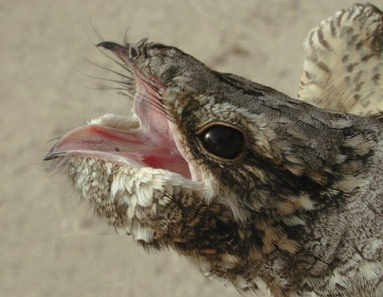Nightjar

Nightjars are birds of legend including the widely held belief that Nightjars sucked the milk of grazing animals. Thus its other name “Goatsucker”.
In reality, Nightjars feed on insects, mainly larger moths. Nightjars migrate to Britain from Africa and return there after rearing their chicks. They arrive in Scotland in May and early June when the moth population explodes. They are most active at the same times of day as moths, at dawn and at dusk. With their large eyes, huge gape surrounded by “whiskers” they are well adapted for catching their prey.
Nightjars are rarely seen during daylight. They remain motionless on the ground, relying on their amazing camouflage - feather patterns that look like dead leaves and old tree bark - to avoid detection. But at night when they are 'churring', they usually perch on the branch of a prominent tree and can be picked out against the night sky. When flying, Nightjar swoop and flap around their territories, often coming very close to any observers.
Males have prominent white markings on the wings and tail, and females have brown markings that are much less prominent. These stand out even at night, so it is often possible to identify the bird's sex. People most often encounter the Nightjar's distinctive sound. Males perform a prolonged churring call ('Nightjar' means night-churr) that may go on for several minutes, varying in pitch and volume. When the birds stop churring, they are often in flight and two other sounds are frequently heard. The first is a rather soft 'coohwick' given as a single note and thought to be a contact call. The second is a slapping or hand-clapping sound caused as the birds clap their wings in flight.
Hearing a Nightjar used to be a not uncommon experience in Arran, but in the latter part of the twentieth century there was a decline. They finally disappeared from their last reported area in Brodick Country Park in 1998. Until last year there were no records on Arran this century. Nightjar like forestry 'clear fell' sites - where all the trees have been cut down - and replanted areas, until the trees are around 15 years old. The increase of these areas in Arran may encourage the re-establishment of the Nightjar. These new heaths provide good nesting cover, plenty of perches and an abundant food supply. At night, radio-tracked birds have been recorded leaving their territories to feed in other habitats, such as deciduous woodland and wet pasture.
Encountering Nightjar in the gloaming is a magic birding moment, if you can thole the inevitable midges.